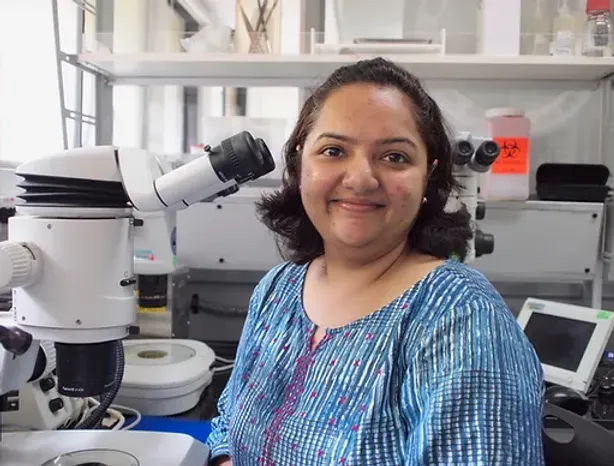Ankita Walvekar is a PhD student in Dr. Neha Vyas’s lab at St. John’s Research Institute and jointly works in the lab of Dr. Raj Ladher at NCBS.

Tell us about the research presented in your winning poster.
The work presented in my poster is a part of my PhD. The poster focused on exosomal secretion of the protein Sonic Hedgehog (Shh) and how distinct exosomal Shh have different functional abilities and biogenesis.
Neural patterning is the process by which the developing spinal cord is patterned to give rise to different neuronal subtypes. Shh is a key secreted signaling molecule involved in this process and is conserved across species. Shh acts as a morphogen and is also involved in the growth and proliferation of the developing ventral neural tube. Until a few years ago, the knowledge of how Shh is secreted was elusive. Previous work from our lab has helped identify that Shh is secreted on exosomes, which are secreted extracellular vesicles that aid in cell communication. we identified that, apart from the classical exosomal pool, Shh is also secreted on another new lighter exosomal pool.
My present work using these different Shh exosomal pools not only confirms the distinct signaling role of these two pools but also identifies the distinct downstream signaling these exosomes can activate.
Why did you pursue this particular topic for your research?
I was initially interested in the areas of cell communication and developmental biology and this project was a good combination of my two interests. My mentor Dr. Neha Vyas had identified a new unique pool of Shh exosomes apart from the classical exosomal pool, which further intrigued me to take up this project to better understand what this newly identified Shh-exosomal pool does.
Great! What’s the one thing about your project that keeps you excited?
Research to me is like solving a jigsaw puzzle. It is the findings that fit in the jigsaw to shape up a research story that keeps me going.
Well put. Shifting gears a bit, among the posters and talks at InSDB24, which one intrigued you the most, and why?
Of the many posters, I liked the one presented by Uttkarsh from Dr. Srikala Raghavan’s lab at inStem. His work focused on the immunological and metabolic aspects of the skin disease Psoriasis. I was fascinated to learn from him about the cross-talk between lactate metabolism and skin inflammation.
Although there were many great talks, the entire session where Prof. Masatoshi Takeichi spoke about the discovery of cadherins, Dr. Ondine Cleaver spoke about pancreatic development, and Dr. Amrutha Swaminathan spoke about using zebrafish as a model to study behavior stood out to me.
What was the most exciting part of participating in the conference?
Catching up with former colleagues, meeting reputed scientists from around the globe, and getting constructive feedback on my research were some of the exciting aspects of the conference.
And, what are some learnings and takeaways you gained from InSDB24?
My biggest takeaway was the scientific feedback that I received from senior scientists from varied areas of biological research. These constructive feedbacks have helped me think about my work from a larger perspective.
I was also particularly in awe of Prof. Lakhotia as I saw him attend almost all the posters and give his valuable feedback to young budding researchers.
Finally, What are your future plans?
Currently, my focus is to get this work published and wrap up my PhD. I would then, hopefully, apply for post-doc positions in cell and developmental biology. Since I have been trained in studying secretory extracellular vesicles, I would be interested in understanding different secretory molecules and how they modulate different biological fluids in development and disease in the long-term future.





